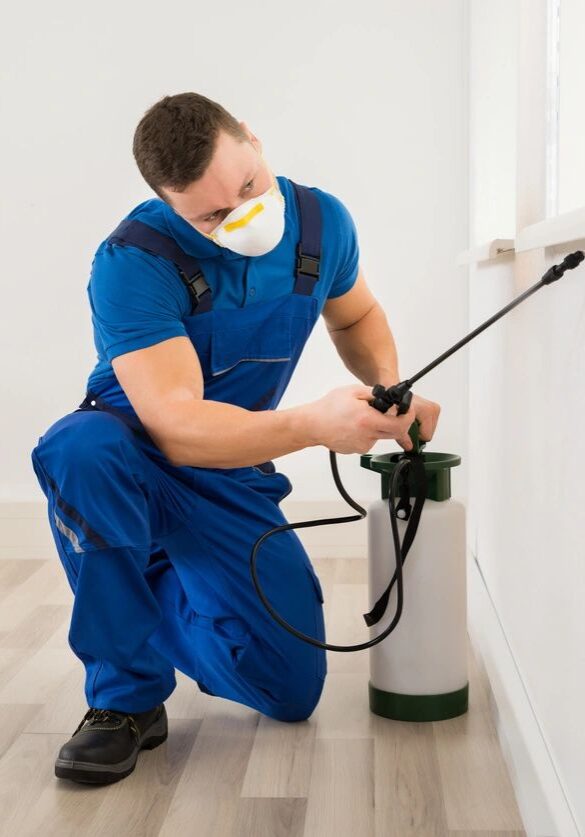Bed Bugs
Providing education on bed bug prevention and eradication.
What are bed bugs?
Bed bugs are parasitic insects. Human blood is their preferred food, but they will also feed on rodents, bats, birds, and pets if humans aren’t available.
How do bed bugs grow and develop?
During its life cycle, a bed bug hatches from an egg into a nymph and molts (sheds its old skin) five times before becoming a full-sized adult, about the size of an apple seed. Eggs are glued onto a surface by the adult female bed bug. All nymph stages and adults require blood meals.
What do bed bugs look like?
Adult bed bugs are small, but visible to the naked eye. An adult bed bug is from 1/4 - 3/8 inches long and reddish brown. Bed bugs have an oval shape with a flattened body when unfed; their body becomes swollen after they have fed.
The young nymph (immature) that has just hatched from the egg is less than 1/10 inches long and nearly colorless, but it becomes red after taking a blood meal. There are five nymph stages, with each stage slightly larger than the preceding one. Nymphs typically are yellowish brown to reddish brown.
How do bed bugs move about?
Bed bugs cannot fly, but they can walk very fast. They are able to cling tightly to surfaces, and they can fit into very small cracks and crevices where they often hide during the day.
Where are bed bugs found?
Bed bugs can be found in places that are frequented or occupied by humans. Bed bugs are most commonly found in dwellings with a high rate of occupant turnovers, such as hotels, hostels, dormitories, apartment complexes, movie theaters, and the like.
Bed bugs also can infest private dwellings. Bed bugs can infest airplanes, ships, trains, and buses.
Where do bed bugs hide?
Bed bugs will hide in mattresses and box springs, bed frames, dressers, upholstered furniture and other furniture, cracks and crevices, electrical outlets, carpet tack strips, baseboards, window and door casings, drapery pleats, wall hangings, ceiling moldings, seams in wallpaper, etc.
Bed bugs prefer to contact fabric, wood, and paper surfaces—all of which are common in human dwellings.
What are the telltale signs of bed bugs?
The most obvious signs of bed bugs are small black spots (feces) deposited in and near bed bug hiding places. Shed bed bug skins, eggshells, and live bed bugs also may be found.
Another sign is bloodstains, which typically occur when a bed bug is squashed. Itchy red welts may be the result of bed bug bites, but other insects, arthropods, and medical conditions can produce similar reactions. It is important to confirm whether the bites were caused by bed bugs by conducting a bed bug inspection.
When do bed bugs feed?
Bed bugs typically bite at night. However, they also can feed during the daytime.
What do bed bug bites look like?
Bed bug bite reactions vary from person to person. Humans often exhibit a range of reactions to the bed bugs’ injected saliva. Some people exhibit no reaction whatsoever, and others experience a raised itchy red welt at the site of the bite.
Bed bug bite reactions often appear as two or more bites in a row. They often occur on exposed areas of the body, such as the face, neck, arms, and shoulders. Bed bug bites may resemble bite reactions caused by other insects and other medical conditions.
How do I treat bites?
Consult your physician. Anti-itching medications and antibiotic salves applied to the skin may be helpful.
Prevention
How are bed bugs spread?
Bed bug nymphs and adults are adept crawlers. They hitchhike from place to place by tucking away in peoples’ clothing, shoes, backpacks, purses, briefcases, luggage, used furniture, mattresses, bedding, etc.
Eggs laid on these items also allow bed bugs to be spread from place to place. When there are multiple units in a building such as in hotels, dorms, and apartments, bed bugs can easily crawl to other units and spread beyond the site of the initial infestation.
How can I protect myself and my family from bed bugs?
Knowing what to look for can keep you from carrying bed bugs into your home. Be on the lookout for the telltale signs of bed bugs when traveling or buying used furniture, bedding, and other used items.
In a work setting where bed bug exposure is possible, follow the safety precautions prescribed for your workplace.

Eradication
Apply nonchemical measures to combat a bed bug infestation.
- Minimize clutter.
- Launder all bedding, clothing, etc. in hot water (at least 120F) and dry on a hot setting for at least 15 minutes.
- Encase mattresses and box springs in plastic covers that have a sealed zipper caulk or seal cracks and crevices.
- Vacuum.
Use integrated pest management (IPM) approach of sanitation to combat a bed bug infestation. Chemical treatment requires a licensed pesticide control applicator who should:
- Apply insecticides to targeted sites
- Rotate insecticide
- Use a variety of insecticides
- Do not rent out an infested unit in a building in isolation.
- Bed bugs move and spread quickly beyond the initial infestation site especially in hotels, dorms, and apartment buildings. Inspect and treat (if necessary) all units that share a common wall with the infested unit.
Information from the Central Ohio Bed Bugs Task Force.
